A Nightmare on Elm Street 2: Freddy's Revenge is overshadowed by the other sequels in the franchise, but the movie actually resolved a big Freddy Krueger mystery regarding his powers. The first of many sequels to A Nightmare on Elm Street, Freddy's Revenge is an underappreciated movie mostly recognized for its queer-cult status. However, despite its unconventional place in the Nightmare on Elm Street legacy, the second installment also holds the secret to Freddy's countless returns.
SCREENRANT VIDEO OF THE DAY
Throughout the series, A Nightmare on Elm Street tried to define who Freddy Krueger was and how his abilities operated. Whether he was the son of a hundred maniacs or a reality-warping demon like in Wes Craven’s New Nightmare, the movies established that Freddy likes to torture his victims in their dreams and his powers depend on how much he is feared or remembered. They also revealed one of the few places where Freddy is vulnerable is the waking world, so his enemies could drag him out and theoretically destroy him there.
As the franchise continued and Freddy returned after being defeated in the waking world multiple times, why didn't anyone just keep him imprisoned in a physical place? If killing Freddy resurrects him in the dreams of teenagers, a mortal body would seem an eternal fate. A Nightmare on Elm Street 2: Freddy's Revenge showed audiences why Freddy couldn’t be kept alive. He is even more dangerous in the waking world, able to manipulate it without any restrictions holding him back.
Why Freddy Krueger Can't Be Locked Up In The Waking World

Many of Freddy Krueger’s plans relied on escaping into the physical world, and in A Nightmare on Elm Street 2’s plot, the slasher briefly succeeded. In the body of high school student Jesse Walsh, Freddy demonstrates that he could warp reality through his host. When set loose from the dream world, Freddy set water ablaze, turned a fence into a scorching force field, conjured up demon dogs with human faces, and teleported through a solid wall. Freddy's powers remained intact when mortal but didn’t seem as confined by the dreamers who conjured him up when he was up close, personal, and very real to his victims. So keeping him locked up probably wouldn’t last long when he can still walk through walls, and it’d only reinforce that nobody is safe from Freddy’s horrifying powers as long as the razor-clawed slasher is still alive.
Killing Freddy could risk another resurrection, but in his victims’ dreams, he’s more manageable. With Freddy mostly limited to one or two dreamers at a time, and only while they sleep, his body count is considerably lower. Also, with fewer witnesses and physical proof, it’s easier for Springwood to cover up Freddy’s presence and stifle the kind of fears he feeds on. Additionally, with the aid of Hypnocil, the movies' dream-suppressing drug, the town can keep Freddy from haunting his victims and hopefully from rising again in another Nightmare on Elm Street sequel. The dream world may be Freddy’s domain, but it also serves as a prison that can hold him, if handled correctly.
A Nightmare on Elm Street 2: Freddy’s Revenge may not get as much fanfare as the other sequels, but the movie offered a further understanding of Freddy Krueger’s dream powers. One of the scariest things about Freddy is how nobody completely knows what he’s capable of doing. Although, perhaps fans of the supernatural killer also known as the Springwood Slasher can sleep a little easier with an answer to another big mystery.
